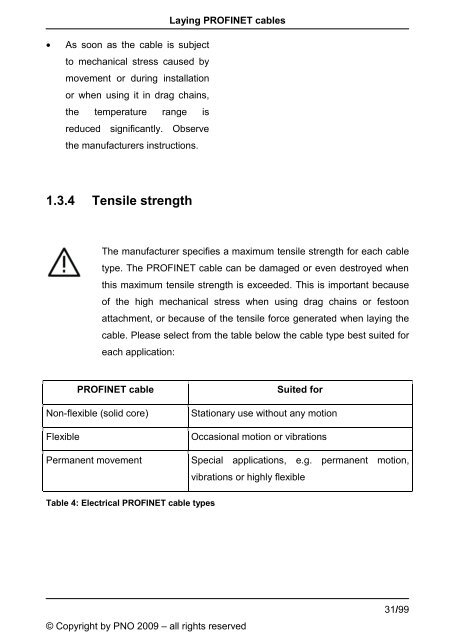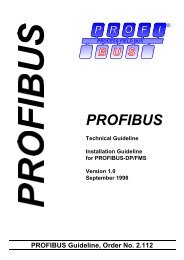PROFINET Installation Guideline for Cabling and Assembly
PROFINET Installation Guideline for Cabling and Assembly
PROFINET Installation Guideline for Cabling and Assembly
Create successful ePaper yourself
Turn your PDF publications into a flip-book with our unique Google optimized e-Paper software.
• As soon as the cable is subject<br />
to mechanical stress caused by<br />
movement or during installation<br />
or when using it in drag chains,<br />
the temperature range is<br />
reduced significantly. Observe<br />
the manufacturers instructions.<br />
1.3.4 Tensile strength<br />
Laying <strong>PROFINET</strong> cables<br />
The manufacturer specifies a maximum tensile strength <strong>for</strong> each cable<br />
type. The <strong>PROFINET</strong> cable can be damaged or even destroyed when<br />
this maximum tensile strength is exceeded. This is important because<br />
of the high mechanical stress when using drag chains or festoon<br />
attachment, or because of the tensile <strong>for</strong>ce generated when laying the<br />
cable. Please select from the table below the cable type best suited <strong>for</strong><br />
each application:<br />
<strong>PROFINET</strong> cable Suited <strong>for</strong><br />
Non-flexible (solid core) Stationary use without any motion<br />
Flexible Occasional motion or vibrations<br />
Permanent movement Special applications, e.g. permanent motion,<br />
vibrations or highly flexible<br />
Table 4: Electrical <strong>PROFINET</strong> cable types<br />
© Copyright by PNO 2009 – all rights reserved<br />
31/99



